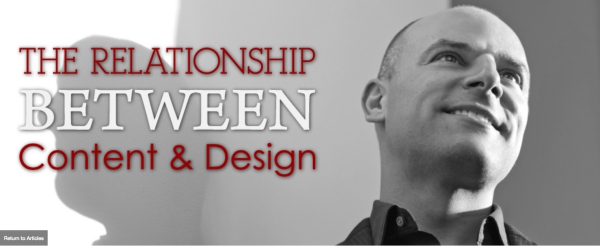
In an interview with Mahyar Saeedi at Designed to Speak, our Chief Content Strategist Rick Sloboda discusses the relationship between content and design, including content-first design.
Rick Sloboda, Founder and Chief Content Strategist at Webcopy+, is a devoted advocate of ‘content-first design’ and suggests dummy text hurts the design industry. In fact, he’s been quoted as saying: “Lorem Ipsum diminishes problem-solving designers into pixel pushers, handcuffs content writers, frustrates users, and shortchanges clients.” We recently caught up with the seasoned communicator who conducts content studies with the likes of Yale University to discuss the relationship between content and design.
Why should content come first?
Properly crafted content is a critical element of user interface design and should help drive design decisions. I’d go as far to say that good content writing is interface design. Content informs and — together with good design — helps people complete tasks. Frankly, people show up for the content, not the design.
What if the content isn’t created properly?
You end up with a flawed foundation. Good design can’t save bad content. I feel sorry for designers who are forced to rely on clients for content, only to receive crappy content that compromises the integrity and effectiveness of a website. I’ve spoken to designers who decided not to put websites with poorly written content in their portfolios because it reflects poorly on them.
What about results for the client?
Indeed, poor content hurts everyone, especially the client. Their brand isn’t well represented, SEO opportunities can be missed, and engagement and conversions are less than ideal or downright dismal. Poorly written content, like poor design, can significantly damage a business’ brand and reputation.
You’ve been quoted in publications speaking out against Lorem Ipsum. Why?
Lorem Ipsum forms the delusion that content is secondary, where designers create aesthetically desirable designs with boxes to be “filled in” later. The problem here is design starts forming how things are communicated before determining what needs to be communicated. It’s like blurting out words and then thinking about what should be said. It doesn’t make sense. Unfortunately, many designers are forced to go this route.
If it’s not an ideal sequence, why do designers apply this process?
Notice I said, “forced.” While some will disagree with me, many web designers will state they do so out of necessity because clients promise content and don’t deliver it on time, or at all. In fact, we’ve partnered on countless website projects where the designer finished all of the deliverables, but couldn’t launch due to the absence of necessary content. After six to nine months of delays, businesses finally agree to call in professional content writers, and a couple of weeks or so later, the sites are finally launched. Meanwhile, consider all the time that was wasted, along with missed opportunities, not to mention pointless frustration and grief.
So how can designers resolve this issue?
Education. Web designers can stress to clients that business objectives and audience needs drive content, and content then influences design decisions. An experienced content writer or specialist identifies key elements during the content research and development process, including corporate objectives and goals, audiences and calls to action. Information is systematically filtered, cleaned up, segmented and prioritized, which shapes information flow and structure. While this approach benefits clients, it also benefits designers, as they know exactly what they have to work with. It takes guesswork, back and forths, and errors out of the equation.
What are fundamentals of effective content and blunders designers should look for?
Common offenders include self-centric and long-winded, jargon-heavy content. Business owners are often guilty of communicating what they want to say versus what visitors want or need to read. If ‘we’ is prevalent in content, chances are the website’s less than optimal. ‘You’-driven, visitor-centric web copy is more engaging and effective. The content should not be written for the writer, or even the business owner. The content should be written for the intended audience. It sounds obvious, but so many websites miss the mark.
Everything in marketing is connected to understanding the audience. The more you know about your target audiences, the more you’ll understand their ‘trigger points’, which leads to why they take action and choose to spend their money. Insight to demographics is great, but we also need to explore, uncover and understand lifestyles, behaviors and attitudes.
Also, flesh out any filler from the content before you add it to the site. Unnecessary words, like unnecessary design elements, are merely a distraction to visitors, which promotes frustration and bounces. Edit, edit and edit some more. Then step away, come back with fresh eyes, and edit again. Especially online, less is more.
Finally, while features have their role, it’s usually best to focus on benefits. For people to take action, they need to care. Benefits tell people why they should care. They engage people and create emotional reactions. We’re emotional creatures; we make decisions emotionally and then rationalize them logically. Benefits get people to act. In addition to talking to customers, a trick seasoned copywriters use to undercover benefits is to keep asking, “So what?” A camera comes with an oversized lens. So what? You’ll gain low-light performance. So what? You’ll capture bright, crisp images from dusk until dawn. And so on. Early on in my writing career, I realized features tell; benefits sell.
Are there any other insights you can share?
To achieve a highly effective website, the web designer and content writer must be on the same page to support the same objectives, address the same audience, and project the same brand characteristics. I believe this collaboration is a natural fit because we’re both branding; only writers brand with words. Working in concert, writers and designers can better serve clients to help them reach their full potential.

Connect with Rick on LinkedIn, or to get strategic content working for you, contact us.






Leave a Reply